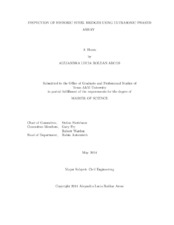| dc.description.abstract | The use of ultrasonic phased array (UPA) technology for inspection of the trunnion bearing pin of the 100-year old Salmon Bay Bascule Bridge is the focus of this research. To thoroughly investigate the bearing pin, two main objectives are addressed: the development of a UPA system, including the design of a case that uses a Poly Methyl Meth Acrylate (PMMA) material to house the transducer, and the implementation of the system in the field to test the feasibility of the UPA system and its application as a nondestructive testing unit.
Two different testing settings are carried out in this research. The first study is performed in a lab-based setting on a mock-up model pin. This model is used as a reference to provide the calibration of the UPA system using the exterior edge, two keyholes, and three diagonal interior grease holes. The second study is performed in a field-based setting on the authentic trunnion bearing pin taken out of service from the Salmon Bay Bridge in Seattle, Washington, currently residing at the Riverside Campus. This pin has three similar diagonal holes, keyholes, and unknown internal defects. Realtime measurements using the UPA system is used to identify the exterior surfaces and the keyholes of the original pin.
The results of the inspection of the pins using the UPA system indicate the accuracy of the real-time data taken from the probe measurements. It was limited to seeing perpendicular defects and exterior sides, and could not identify the diagonal grease hole within both pin parts. It did, however, identify the keyholes, and was later verified by visual inspection once the sleeves were removed. The original pin showed no internal defects.
For future research in nondestructive testing used in historic trunnion pins, it is recommended to combine this technology with an automatic system that allows the reduction of human interaction with the inspection. A membrane-like surface adaptable to rough faces, along with a constant flow of water between the wedge and surface, would facilitate the need to remove the PMMA case out of the pin to re-apply couplant for inspections. Finally, a modified angled wedge could also be applied within the PMMA case to search for different angled cracking. | en |


